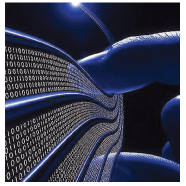By: Brenda J. Trainor

The economy has been pretty chaotic; election year politics are pretty chaotic, even the weather seems out of sync with normal: it seems we are due for some great changes.
If you are running a business, new technologies are likely introducing some chaos into the old ways that you marketed your operations and related to your customers. New technologies of social media and mobile communications systems will force you to change your marketing strategies just to keep up with your customers and how they choose to spend their money.
For small and medium sized businesses, adapting to new technologies can be especially challenging. Many don’t have the staffing capacity to dedicate a full-time staff person to be the social media manager. Yet, it is becoming increasingly important to dedicate significant resources for your business to be a master of social and mobile media strategies.

Not too long ago, it was important to have email, then it became important for a business to have a web site. But that is no longer enough: consumer-oriented businesses that ride the waves of a stormy economy must also cruise along with social media: Facebook, Twitter, Foursquare, MySpace, and the latest trend, Pinterest, are becoming essential spaces where your business must have a presence.
Customers Feel the Chaos Too
The challenge of communicating with customers is complicated with new media. We know that lots of potential customers are walking around with their smart phones and using them in new ways for commerce. A trip to IKEA is now akin to walking into a photo studio, as customers shoot pictures with their iPhone of potential items for purchase and either keep them for reference or email them on the spot back home to the spouse who hates to shop.
Customers now whip out a smartphone to target a QR code, those funky black-and-white patterned squares that link to a web site that might have special offers or ideas for related merchandise. They “like” a brand on Facebook, and write reviews on Yelp, connect in your store with Foursquare, compare prices on the spot, and when they go home, they look for coupons and special offers from your competitors or post a picture of their favorite product on Pinterest, all from the comfort of their lounge chair with a computer or an iPad on their lap.
Not surprisingly, customers sometimes get a little overwhelmed with their own technology. Each spring, many hipsters celebrate the “National Day of Unplugging” after pledging the Sabbath Manifesto (www.sabbathmanifesto.org) as a way to get off the grid, “disconnect, reflect, and take stock.” Businesses need to appreciate that too much technology can scare off customers; not enough technology, and you lose potential clients.
Being Great by Balancing Old and New
In a decade, we’ll see that the businesses that are still around succeeded because they found a balance between old business strategies and new technologies. People (aka customers) will always appreciate honesty, ethics, fair pricing and excellent service. They also appreciate the conveniences that technology enables: quick information about pricing, reliable facts about products, simplicity in making payments and returns. That means that these businesses made the investment in staffing, knowledge and resources so that their electronic communications worked easily and quickly.
For now, that means that customers get responses to emails, tweets are monitored and responded to, Facebook offers are timely, and smartphone apps present information that fits on the various screen formats for various technologies like iPhones, Blackberries, iPads, and Kindles (why don’t we have a screen ratio standard?). It means that your brand has adapted to the new Facebook layout and the evolving Pinterest page format. It means your business communications are graphically sophisticated, and copy is creative and succinct. You’re efficient in your messaging, and accurate in your customer relationships. It means, quite simply, that being great means making a big investment in time and energy to stay current with the constantly changing ways that we communicate in business and in life.


|